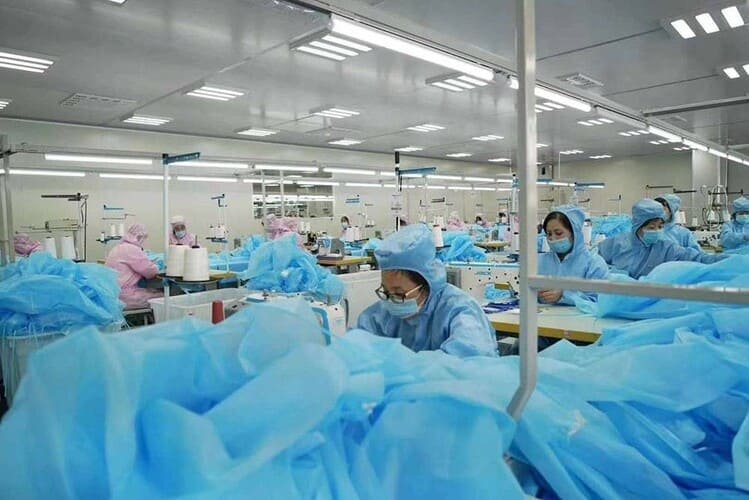Best Disposable Coveralls For Construction

Disposable coveralls are essential for construction workers, providing protection against hazards like chemicals, dust, and abrasions while ensuring hygiene and comfort. Materials such as SMS, Tyvek, and microporous film offer durability, breathability, and resistance to fluids, meeting diverse site needs. Options like Type 5/6 coveralls ensure safety from particles and light splashes, while features like elastic hoods, cuffs, and taped seams enhance protection. Choosing the right coverall ensures regulatory compliance, safety, and cost-effectiveness. At Morntrip, we offer high-quality disposable coveralls tailored to your needs. Contact us for expert guidance and free samples to ensure quality and satisfaction.
Cpe Gown Vs. Other Isolation Gowns: Key Differences Compared

CPE gowns are a cost-effective and highly protective choice, offering superior fluid resistance, durability, and versatility compared to PP and SMS gowns. Made from chlorinated polyethylene, these gowns are waterproof, resistant to chemicals, and designed for critical zones. They are widely used in healthcare, food safety, laboratories, and industrial settings, providing effective protection against contaminants. CPE gowns are 30%-80% more affordable than other gowns due to efficient, automated production. At Morntrip, we specialize in high-quality CPE gowns tailored to your needs. Contact us today for expert sourcing support and free samples to ensure the best quality for your requirements.
How To Wear A Shower Cap?

Shower caps are essential for protecting hair, maintaining hairstyles, and enhancing treatments like deep conditioning. Available in reusable and disposable designs, they cater to various needs with waterproof materials, adjustable sizes, and stylish prints. Learn how to choose the right cap, wear it effectively, and clean it for repeated use. Morntrip offers high-quality, customizable disposable shower caps and headwear solutions to meet unique requirements. Contact us today for reliable, tailored products that fit your needs.
The Complete Guide To Disposable Surgical Caps: Types, Benefits, And Uses

Disposable surgical caps are vital for infection control, offering hygiene, comfort, and cost-effectiveness in healthcare and sterile environments. Made from materials like polypropylene and SMS, they come in various types, including standard caps, bouffant caps, elastic-back caps, and surgical hoods, each suited for specific uses. With options tailored to material, purpose, and environment, these caps prevent contamination while ensuring convenience. Morntrip provides customizable, high-quality solutions for bulk purchasing to meet industry needs.
What is a Bouffant Cap?

Bouffant caps are critical protective gear designed to prevent contamination across healthcare, food processing, pharmaceutical, electronic, and laboratory industries. Available in disposable and reusable options, these versatile head coverings are made from materials like polypropylene and cotton blends, featuring an elasticized fit and sizes accommodating various head shapes.
The guide explores their industry applications, material considerations, and proper usage techniques. By selecting the right bouffant cap, professionals can enhance workplace safety, maintain hygiene standards, and protect sensitive environments from potential contamination.
Complete Guide to the Types and Applications of Disposable Caps

Disposable caps are essential for maintaining hygiene, preventing contamination, and ensuring comfort across various industries. This comprehensive guide delves into different types of disposable caps, including bouffant caps, mob caps, hair nets, and more. Learn about their features, materials, and specific applications in healthcare, food service, laboratories, and beauty services. Choosing the right cap enhances safety and efficiency, making it critical to partner with a reliable manufacturer.
Everything You Need To Know About Kids Disposable Lab Coat

This article covers the growing need for Kids Disposable Lab Coats in schools, from science classes to art activities. It details the benefits of these lab coats, including protection from spills and allergens, and highlights factors to consider when buying, such as material quality, fit, and comfort features. Practical tips on sourcing options are also provided, helping educators find cost-effective solutions for safe, hands-on learning.
What’s The Purpose of A Disposable Lab Coat?

The article covers the essentials of disposable lab coats, detailing their protective features, common applications, and selection criteria. It explores materials like polypropylene, SMS, and Tyvek for their unique protective qualities in lab and healthcare settings. The guide also provides tips on choosing the right coat, considering factors such as material, size, and intended use. Finally, it offers advice for sourcing quality lab coats, highlighting the importance of supplier reputation, product quality, and bulk pricing to meet safety standards effectively in professional environments.
Isolation Gown Vs Surgical Gown: A Comprehensive Comparison

The blog explains the key differences between isolation gowns and surgical gowns, focusing on their materials, designs, protection levels, and intended uses. Isolation gowns are lightweight and designed for low to moderate risk situations, offering general protection. In contrast, surgical gowns provide high-level protection for sterile environments like operating rooms. They feature reinforced areas and comply with stricter standards. The article helps healthcare professionals choose the right gown based on their specific needs and scenarios.
Why Sustainability Matters: The Rise of Biodegradable Isolation Gown Factory

The blog discusses the environmental impact of traditional non-biodegradable personal protective equipment (PPE) and highlights the emergence of biodegradable isolation gowns as a sustainable alternative. It examines factors driving demand for sustainable PPE, such as increased environmental awareness, regulatory changes, and corporate responsibility. The article also explores biodegradable materials like polylactic acid (PLA) and polyhydroxyalkanoates (PHA), their advantages over traditional materials, and profiles industry leaders in biodegradable isolation gown manufacturing.

